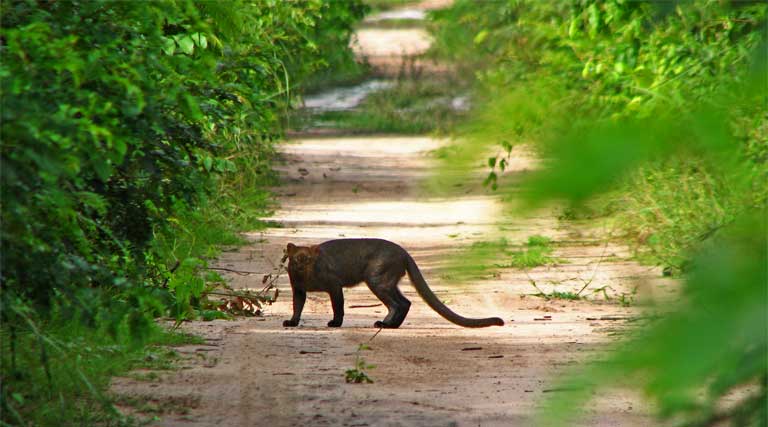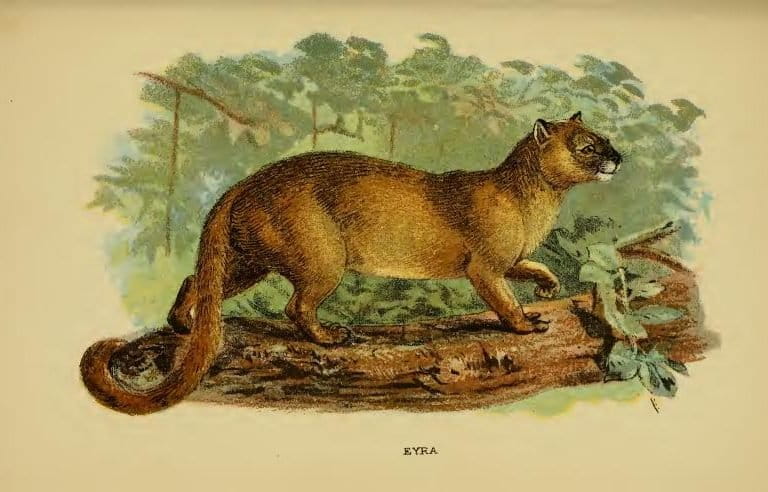- Last Monday, in an article about Brazil’s Cerrado, this Mongabay editor mistakenly identified an animal in a photo as a puma (Puma concolor).
- Within hours multiple readers corrected that mistake, properly identifying the animal as a jaguarundi (Herpailurus yagouaroundi).
- Curiosity aroused, this editor went to work learning more about jaguarundis.
- Most interesting find: these small cats of North, Central and South America, were until recently on track to be reintroduced to Texas, but a new president and his plan for a U.S. / Mexico border wall has put those plans in limbo.

Thanks to some eagle-eyed Mongabay readers, a photograph accompanying this week’s story about Brazil’s Cerrado was correctly identified as an image of Herpailurus yagouaroundi, and not Puma concolor, as first indicated in the photo caption.
In the picture as published, a cat is seen crossing a dirt road, its head mostly in deep shadow. Without a comparative object to determine relative size, and an unclear view of the face, it was mistaken for a larger feline species. With pumas considered the largest of the small cat species, it was an honest mistake.
Within hours of publication Mongabay was emailed by three readers, who advised us that this was, in fact, a photo of a jaguarundi. Thank you for letting us know so quickly.
Looking at the original photo, both my wife and I assumed we were looking at the back of the cat’s head as it faced away from the camera. As the Jaguarundi is one of only a few wildcats in the world not to display alternate coloring on the back of its ears, we figured it would be easy to confirm a positive ID once the photo was enlarged and brightened.

Adjustments done, and to our surprise, the small head, distinct blue eyes, and unmistakable features of a grey phase, male jaguarundi emerged from the shadows looking directly at the camera. What a catch our readers made!
Both the puma and the jaguarundi inhabit different niches across much of the same range throughout southern North America, Central, and much of South America. The puma, alternately known as a cougar, panther, or catamount, is more widespread in mountainous regions while the jaguarundi roams a wider variety of habitat including dense scrubland, savannah and primary forest. Prior to 2017, there were more than eight recorded subspecies, but current DNA analysis now recognizes only a single genus, Herpailurus.
Unfortunately for the jaguarundi, it is turning out to be a victim of heightened U.S. border security. The animals once freely roamed the Rio Grande Valley of Texas, but have been listed as Endangered in the region since 1976, with the last official sighting in 1986.
As security tightened between the U.S. and Mexico, the jaguarundi population in Texas was cut off from potential mates over the Mexican border. An official recovery plan, researched and funded by the U.S. Fish and Wildlife Service, has been in place since 2014 to reintroduce this important predator into its former territory, but implementation and funding are currently on hold as potential new border barriers loom.
Mongabay is always grateful to our attentive readers who let us know when we get it wrong. Through your quick catch, we got to spotlight this little known felid and the associated, small miracles we often take for granted – like a lucky walker with a camera on a Cerrado dirt road. We’re fortunate to live in a time when we can all see and admire these threatened – properly identified – wildcats online, minus equatorial heat, mud and mosquitoes.

